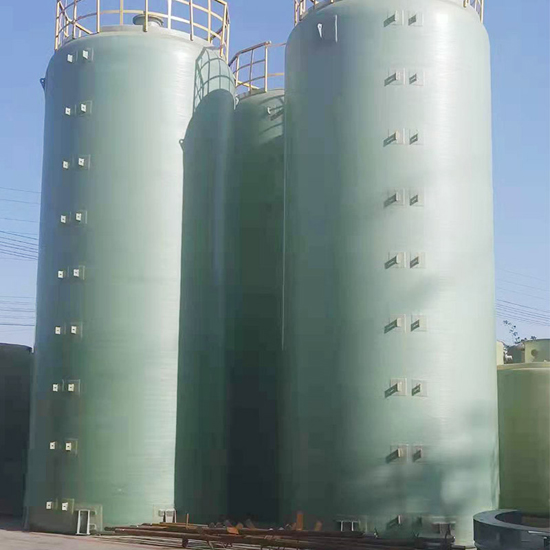FRP Tank and Special Liquid Tank
FRP tank is suitable for the storage, fermentation and reaction of many materials such as soy sauce, vinegar, pure water, food ingredient of ion grade, hydrochloric acid of food grade, seawater desalination and storage system, seawater transportation system, etc.
What is FRP tank?
contact us is suitable for the storage, fermentation and reaction of many materials such as soy sauce, vinegar, pure water, food ingredient of ion grade, hydrochloric acid of food grade, seawater desalination and storage system, seawater transportation system, etc.

FRP/GRP/GFRP/Fiberglass/composite vessel/tank can be divided
I. By shape:
Horizontal tank/vessel, vertical tank/vessel with flat bottom, vertical tank/vessel with conical bottom, vertical agitating tank/vessel with flat roof, open top vertical tank /vessel, alien tank/vessel
II. By manufacturing method:
Shop tank/vessel (within DN 4m), on site tank/vessel (DN 4m - 25m), including FRP tank/vessel combined with PVC, CPVC, PP, PE, PVDF, etc.
III. By application:
Chemical storage, stress reaction kettle, scrubbing tower, spray tower, food fermentation, ultrapure water storage, transportation vessel for train and vehicle
Typical process flow of FRP vessel
1. Design and confirm the drawings and calculation notes
2. Prepare the appropriate equipment and mold
3. Make the seamless liner with special spraying gun
4. Wind the structural layers with program computer
5. Hydrostatic test
6. Package and delivery
Brewing/fermentation tank property description
FRP brewing/fermentation tank is one of the successful applications of FRP tank in food fermentation industry.
Take the soy sauce fermentation as an example: the fermentation can be divided into watery state fermentation, solid state fermentation and solid-and-liquid fermentation based on different water content; while based on the salt content, it can be divided into salt fermentation, low-salt fermentation and non-salt fermentation; while according to the temperature needed by fermentation, the fermentation can be divided into natural fermentation and warm-keeping short time fermentation. During the fermentation process, not only the sanitation and anti-corrosion are required, the temperature should also be controlled, and FRP tanks can meet these properties and also control the temperatures by adding water jacket or coiler, and ultimately make different manufacturers of soy sauces keep their own special tastes and qualities. In the same way, the vinegar FRP storage tank occupies the above-mentioned properties.
The common specifications contain: 50m3, 60m3, 70m3, 80m3, 90m3, 100m3 and 120m3, with corresponding diameter scope as 2600mm, 3000mm and 4000mm. 40ºC-70ºC is recommended as common operational temperature.
In order to drain materials clearly, slope or conical bottom can be selected by customer. If the tank will be used in cold area, insulation layer can be covered to ensure the technical requirements.
Property Description
1. The surface of resin-rich layer should be smooth and clean, without damage, whitening, delamination, foreign inclusion and exposed fiber. The convex-concave larger than 3mm in diameter and 0.5mm in depth (height) is not allowed; For the pressure vessel, the max. allowable air bubble is 4mm in diameter. Within the area of 1 m2, the air bubble within DN 4mm should be no more than 3, otherwise the repair should be given; the depth of crack should be no more than 0.2mm.
2. The outer surface should be smooth and even color without whitening. Fiberglass must be impregnated with resin. Foreign inclusion, exposed fiber, interlayer delamination, delamination and resin blister, etc. are prohibited.
3. For the resin content, it should be more than 90% in resin-rich layer, more than 75±5% in middle layer, more than 35±5% in structural layer and more than 90% in outer layer.
4. The taper angle at the inner wall of tank is no more than 1°.
5. Under the loading condition, the allowable hoop strain should not exceed 0.1%.
6. When the winding layers are wound at helical winding angel 80°, its tensile strength should be equal to or more than 15MPa.
7. Barcol hardness on proudct's surface should be no less than 40.
8. Water absorption should be no more than 0.3%.
9. Length tolerance (distance between the peaks of two ends) is 1%.
10. The tolerances of tower's straightness and installation verticality are both 1/1000mm tower's height.
11. The difference between the max. diameter and min. diameter from the same section of the shell should not exceed 0.5% of shell ID.
12. Verticality between flange surface and stub should be conformed to the following table:
| Nominal DN of flange stub | ≤100 | <250 | <500 | <1000 | <1800 | <2500 | <3500 | <4000 |
| Verticality | 1.5 | 2.5 | 3.5 | 4.5 | 6 | 8 | 10 | 13 |
13. Angle deviation of flange stub should be conformed to the following table:
| Nominal DN of flange stub | <250 | ≥250 |
| Allowable angle toleranceφ | 1° | 0.5° |
14. If nominal diameter of pipe joint is no more than 50mm, it should be capable to bear the torque loading of 1360N·m without any damage; if more than 50mm, 2700N·m.
15. The pipe joint should be able to bear the following torque loadings without damage.
| Pipe joint size(mm) | 20 | 25 | 32 | 40 | 50 | 65 | 80 | 100 | 150 | 200 |
| Torque loading (N·m) | 230 | 270 | 320 | 350 | 370 | 390 | 400 | 430 | 470 | 520 |
For more information about FRP tank, feel free to contact us.